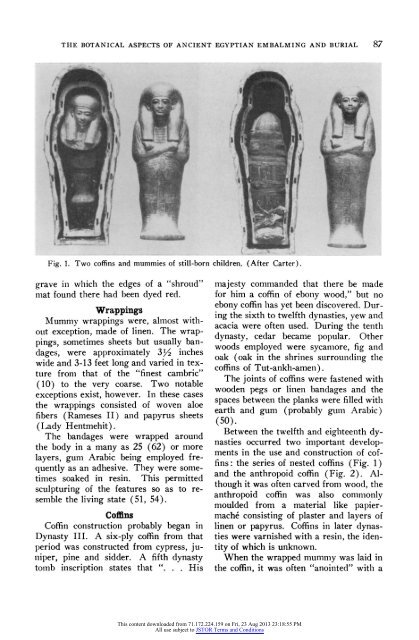The Botanical Aspects of Ancient Egyptian Embalming and Burial
The Botanical Aspects of Ancient Egyptian Embalming and Burial
The Botanical Aspects of Ancient Egyptian Embalming and Burial
Create successful ePaper yourself
Turn your PDF publications into a flip-book with our unique Google optimized e-Paper software.
THE BOTANICAL ASPECTS OF ANCIENT EGYPTIAN EMBALMING AND BURIAL 87<br />
Fig. 1. Two c<strong>of</strong>fins <strong>and</strong> mummies <strong>of</strong> still-born children. (After Carter).<br />
grave in which the edges <strong>of</strong> a "shroud"<br />
mat found there had been dyed red.<br />
Wrappings<br />
Mummy wrappings were, almost without<br />
exception, made <strong>of</strong> linen. <strong>The</strong> wrappings,<br />
sometimes sheets but usually b<strong>and</strong>ages,<br />
were approximately 3X2 inches<br />
wide <strong>and</strong> 3-13 feet long <strong>and</strong> varied in texture<br />
from that <strong>of</strong> the "finest cambric"<br />
(10) to the very coarse. Two notable<br />
exceptions exist, however. In these cases<br />
the wrappings consisted <strong>of</strong> woven aloe<br />
fibers (Rameses II) <strong>and</strong> papyrus sheets<br />
(Lady Hentmehit).<br />
<strong>The</strong> b<strong>and</strong>ages were wrapped around<br />
the body in a many as 25 (62) or more<br />
layers, gum Arabic being employed frequently<br />
as an adhesive. <strong>The</strong>y were sometimes<br />
soaked in resin. This permitted<br />
sculpturing <strong>of</strong> the features so as to resemble<br />
the living state (51, 54).<br />
C<strong>of</strong>fins<br />
C<strong>of</strong>fin construction probably began in<br />
Dynasty III. A six-ply c<strong>of</strong>fin from that<br />
period was constructed from cypress, juniper,<br />
pine <strong>and</strong> sidder. A fifth dynasty<br />
tomb inscription states that ". . . His<br />
majesty comm<strong>and</strong>ed that there be made<br />
for him a c<strong>of</strong>fin <strong>of</strong> ebony wood," but no<br />
ebony c<strong>of</strong>fin has yet been discovered. During<br />
the sixth to twelfth dynasties, yew <strong>and</strong><br />
acacia were <strong>of</strong>ten used. During the tenth<br />
dynasty, cedar became popular. Other<br />
woods employed were sycamore, fig <strong>and</strong><br />
oak (oak in the shrines surroundinig the<br />
c<strong>of</strong>fins <strong>of</strong> Tut-ankh-amen).<br />
<strong>The</strong> joints <strong>of</strong> c<strong>of</strong>fins were fastened with<br />
wooden pegs or linen b<strong>and</strong>ages <strong>and</strong> the<br />
spaces between the planks were filled with<br />
earth <strong>and</strong> gum (probably gum Arabic)<br />
(50).<br />
Between the twelfth <strong>and</strong> eighteenth dynasties<br />
occurred two important developments<br />
in the use <strong>and</strong> construction <strong>of</strong> c<strong>of</strong>fins:<br />
the series <strong>of</strong> nested c<strong>of</strong>fins (Fig. 1)<br />
<strong>and</strong> the anthropoid c<strong>of</strong>fin (Fig. 2). Although<br />
it was <strong>of</strong>ten carved from wood, the<br />
anthropoid c<strong>of</strong>fin was also commonly<br />
moulded from a material like papiermache<br />
consisting <strong>of</strong> plaster <strong>and</strong> layers <strong>of</strong><br />
linen or papyrus. C<strong>of</strong>fins in later dynasties<br />
were varnished with a resin, the identity<br />
<strong>of</strong> which is unknown.<br />
When the wrapped mummy was laid in<br />
the c<strong>of</strong>fin, it was <strong>of</strong>ten "anointed" with a<br />
This content downloaded from 71.172.224.159 on Fri, 23 Aug 2013 23:18:55 PM<br />
All use subject to JSTOR Terms <strong>and</strong> Conditions
















